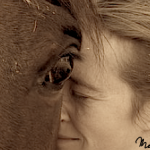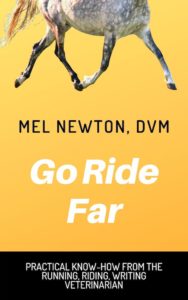CC- Chester answer
| April 1, 2013 | Posted by Melinda under Uncategorized |
horsetech was spot on! (leave your email address in the comments or email me at [email protected] and I’ll get your mailing address and I’ll send you a little something for playing!)
If you compare the right hock to the left hock, you will see diminished joint space, which is indicative of “arthritis” and is a common finding. I’m told that it is fairly common to see changes in one hock and not the other in ropers, and the side they show the changes on, is related to whether they are headers or heelers. If you are heeler you always turn out of the box on the same side, and if you are a header, you are turning out of the box the other way – thus one hock will experience more wear and tear than the other.
Obviously I made up this case and found the images off the internet…..let’s assume that Chester’s affected hock has fused and he isn’t actually in any discomfort……but he’s not moving symmetrically between the left and right hock because one is fused and the other is not. This now is a “mechanical” lameness, meaning that Chester is not in any discomfort or pain, but there is something in his body that is not allowing him to move symmetrically, thus giving the appearance of unsoundness.
Should a horse that is mechanically lame be allowed to do endurance?
I know several horses that have letters from their vets stating that the horse has a mechanical lameness, is not in discomfort and should be considered “sound”,even if the asymmetrical gait for endurance purposes.
How not sure how endurance vets handle this situation. Do they look for changes throughout the ride that indicate that the horse is unsound beyond the initial mechanical lameness? What if the vet who evaluates the horse at the vetcheck is different from the one that evaluated the horse at the beginning of the ride?
Theoretically, I think that mechanically lame horses shouldn’t be excluded from endurance – after all the point of the vet check is for the welfare of the horse, and if a horse is not suffering or in pain and just happens to move a bit differently, then we are operating within the intention of the rules.
Practically speaking it gets a bit messy. Leaving aside the issue of possible increased wear and tear that could occur with a mechanical lameness after 50 or a 100 miles (notice all the modifiers in that sentence – it’s pure conjunction since wear and tear happens with a perfectly sound horse over 50 or a 100 miles – but from the standpoint of physics it makes sense that the biological system is going to end up compensating some how…..) there is the problem of making sure the horse isn’t becoming unsound as the race goes on, consistency between vets, and the “appearance” of an unsound horse being allowed to go on. Do we then allow a mechanically lame horse that wins a ride to show for BC? Does quality of the gait matter in that exam but not for completions?
On the flip side, in this case we are dealing with a fused hock…..an issue MANY horses in endurance have bilaterally and thus isn’t apparent….So do we exclude a horse that has a common issue, but only on one side, while allowing horses with the same bilateral issue that are “mechanically lame” on both sides (and thus inapparent) to compete? If there is solid evidence that continuing to ride a horse with arthritic hocks that eventually fuse does not harm (and as far as I have researched, this is the case) does it change this issue? Is it an unsoundness?
I think one thing to keep in mind, is that in no sport are the issues completely black and white, and if you can’t see the grey, you probably haven’t considered the issue deeply enough. That goes for drug rules, the definition of soundness, and practically every other major issue you can think of. Often rules and decisions made by the “authorities” is the attempt to be as consistent and fair to all participants as possible. I’m not sure what I would do with an obviously mechanically lame horse that otherwise should be able to do endurance. As a participant or as a ride vet. It’s not a simple issue and having a declaration from that animal’s vet is just part of the equation.












Mel–Head horses and heel horses both turn to the left in a roping run, even though they start from the left and right sides of the chute respectively. Some horses routinely start in the left lead, others break in the right lead and change to the left in the turn. But they all turn left and are in the left lead when they turn, which is one reason most rope horses prefer to lope in the left lead. Bone spavin is VERY common in older rope horses, but I’m not aware of it being more common in one hock than the other–but perhaps I just didn’t pay attention to this aspect.
I’ll double check with the.vet I got this from, it’s totally possible.that I got it wrong! Thanks for the info and clarification
Very interested in the answer as to how vets handle this. I know a horse with a mechanical lameness due to what I’ve heard described as stringhalt. Horse is as sound as it will ever be, keeping her in consistent work keeps it less obvious, and in my opinion would likely be capable of a 25-mile LD with no ill effects.
Owner’s impression is that horse will not vet out sound – a bit disappointing for what was intended to be her NATRC/LD horse.
Definitely a gray area, and a potentially expensive one for the riders who likely never know quite what to expect!